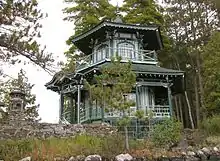Pine Tree Point
Pine Tree Point is an Adirondack Great Camp on Upper St. Regis Lake.[1]

History
Pine Tree Point was the camp of Frederick William Vanderbilt,[2] a director of the New York Central Railroad for 61 years. Vanderbilt maintained residences in New York City at 450 Fifth Avenue, Hyde Park ("Vanderbilt Mansion National Historic Site"), Newport ("Rough Point"), and Bar Harbor ("Sonogee").[3][4]
Vanderbilt hired Japanese artisans from the Pan-American Exposition of 1901, held in Buffalo to construct Japanese-style buildings, remodel existing buildings, including a pagoda with an elaborate spiral staircase, and a Japanese cottage. Servants were required to wear Japanese clothing while waiting on guests; some of the servants were mortified.[5]
In the early 1900s, Herbert L. Pratt purchased Pine Tree Point from Vanderbilt.[5] Pratt was the son of Standard oil industrialist Charles Pratt, and like his father before him, was a leading figure in the U.S. oil industry and head of Standard Oil Company of New York from 1923. This company eventually became Mobil.[3]
Gallery
 Pine Tree Point
Pine Tree Point Dock aka the Front Dock
Dock aka the Front Dock Main Lodge
Main Lodge
References
- Schneider, Paul (2016). The Adirondacks: A History of America's First Wilderness. Henry Holt and Company. p. 264. ISBN 978-1-250-13520-9. Retrieved 11 March 2020.
- "Camps Along the St. Regis Chain of Lakes Now the Goal of the City Folk" (PDF). The New York Times. June 25, 1911. Retrieved 11 March 2020.
- Gilborn, Craig. Adirondack Camps: Homes Away from Home, 1850-1950. Blue Mountain Lake, NY: Adirondack Museum; Syracuse: Syracuse University Press, 2000.
- O'Leary, Ann S. (1998). Adirondack Style. Clarkson Potter/Publishers. ISBN 978-0-609-60361-1. Retrieved 11 March 2020.
- Gould, Jim (2001). Rooted in Rock: New Adirondack Writing, 1975-2000. Syracuse University Press. p. 331. ISBN 978-0-8156-0701-4. Retrieved 11 March 2020.
